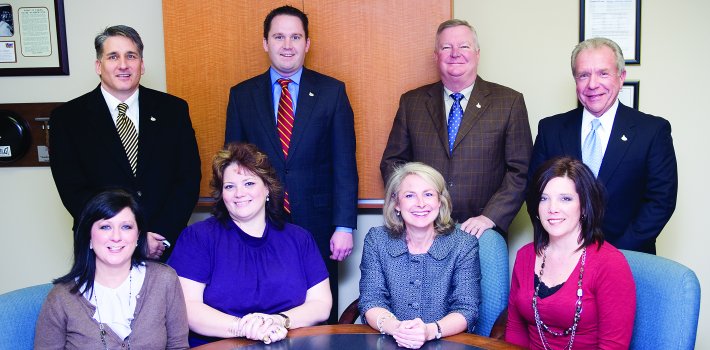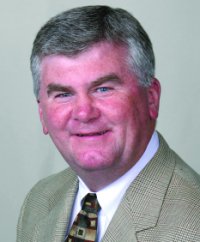
opportunities were growing and were going
to continue to grow…Benefits has really been
our savior."
-Robert M. Bramlett Jr.
President/Chief Executive Officer
BRAMLETT AGENCY STRIKES OIL IN THE BENEFITS FIELD
New niche becomes company's "savior"
By Len Strazewski
The Oklahoma oil fields are an American icon-a symbol of an era when wildcat drillers struck it rich with gushers of black gold. Oil and natural gas drilling and exploration companies gushed with jobs and revenue, creating opportunity for smaller support businesses and professional service firms.
But all gushers dwindle eventually and by the beginning of the 1970s, the era of the black gold rush in Oklahoma was essentially over. The oil and gas industry is still a top employer in Oklahoma and Arkansas, but in the past 30 years or so, revenues and payrolls have shrunk, causing other area businesses to seek new markets and opportunities to sustain revenues.

|
| "We needed a field in which revenues and opportunities were growing and were going to continue to grow…Benefits has really been our savior."
-Robert M. Bramlett Jr. |
The Bramlett Agency in Ardmore, Oklahoma, still specializes in the risk management needs of the oil and gas industry, focusing on reducing the total cost of risk in the workers compensation-driven field. But the agency has also developed a new specialty to drive the future success of the agency-employee benefits.
"As the oil and gas industry began to contract in Oklahoma some 20-plus years ago, it became clear that we would have to learn something else to sustain our business and allow us to continue to grow," recalls Robert M. (Bob) Bramlett Jr., president and chief executive officer.
The Bramlett Agency was founded in 1948 by Jim and Mary Jane Bramlett. In 1975, their son, Bob, joined the firm. Upon his parents' retirement, Bob purchased the agency in 1982, with all of its future challenges.
The answer to problems caused by the changing economics wasn't in the property/casualty insurance business, Bob decided, even though the agency continued to expand its risk management and risk reduction expertise. "The soft property/casualty insurance markets were also driving down premiums and our revenues. We needed a field in which revenues and opportunities were growing and were going to continue to grow," he observes.
Employee benefits, with premium volume fueled by steadily escalating health care costs, was a natural target and the perfect opportunity for the family-owned agency in the relatively small community of 30,000 people.
Today, employee benefits accounts for about half of the agency's revenue, and is the fastest growing portion of agency business. "Benefits has really been our savior," Bob says.
The agency has 16 employees, including four commercial lines producers and one financial planning and personal lines producer. All of the commercial lines producers, which includes Bob Bramlett himself, handle property/casualty risk management as well as employee benefits, though in varying degrees, he notes. And all of the producers reflect the agency's modern risk management approach with their title "risk reduction specialist."
Client employers average about 50 employees, but size ranges go from very small businesses to a regional hospital with 2,500 employees.
The Bramlett Agency is a member of the Bainswest, Inc., in Tulsa, a consortium of 17 independent agencies in Oklahoma and Arkansas. The group was founded in 1993 by Tim Driskill, CIC, of Joe West Company, and Bruce Schutte and Jim Beavers of The Arrow Group as a way to lend leverage to their local agencies. Six months later, Thad Leonard of Carl M Leonard & Son joined the firm. In the late 1990s and early 2000s, the remainder of members, including The Bramlett Agency, became affiliated with Bainswest.
The Bramlett Agency outsources accounting and other back-office support functions to Bainswest. Bob Bramlett is a principal of Bainswest, and he says the cluster approach allows his agency to be more efficient, focusing on its insurance and risk management expertise rather than general office functions.

|
| Jane Seals, Risk Reduction/Employee Benefits Specialist, visits with Ivan Otero of client Wilkinson Nursery & Landscape Co. |
Bramlett Agency Senior Vice President and Chief Operating Officer Neil Johnson says that expertise is the single greatest value the agency provides to its employee benefits clients. Though many of the clients are too small for advanced plan designs-only a few clients have implemented consumer-directed health plans-all of them are hungry for ideas that could reduce their risks and, eventually, their costs.
"The most important thing we can do to market the agency is to establish ourselves as a good source of information," he explains. "Group health insurance premium increases have been all across the board-a low of 3% to 4% for some employers and 15% to 25% for others--but everybody is looking for ways to hold costs down in the future."
The agency presents quarterly "lunch and learn" seminars for present and prospective clients, drawing 40 to 50 attendees. Benchmarking is a hot topic, Johnson says, as local employers attempt to match their employee benefits programs against their peers.
Wellness is another hot topic and an approach consistent with the agency risk reduction philosophy. Few clients have implemented comprehensive wellness programs with health screenings, incentives and premium adjustments for adherence, but most clients are interested in the approach, he says, and could be on the verge of moving forward.
"Many employers are ready to implement some steps in wellness," he says, but even the best wellness experts have difficulty putting a financial value on wellness programs. The more expensive health screening programs are likely to be the most successful since they identify clear and eventually expensive health risks.
However, because simple steps could be enough to make a difference in costs, employers are interested in employee education programs. "It's a very proactive approach to encourage employees to be more concerned about their personal health. Employees can be encouraged to watch what they eat, get more exercise and get an annual checkup."

|
| "For me, it is a labor of love. It's my passion to support these businesses." Jane Seals, Risk Reduction/Employee Benefits Specialist |
Local health plans are also supporting wellness programs with education programs and are beginning to support adherence with incentives, including a reduced deductible for employees who complete health risk assessments and make progress in a wellness program.
Leading health plans in the area include Blue Cross/Blue Shield of Oklahoma, United Health, Aetna Health and a regional carrier, Harrington Health in Wichita, Kansas.
Jane Seals, Bramlett risk reduction specialist and employee benefits specialist, also administers one of the agency's most successful health care programs for small businesses that may have difficulty obtaining and affording health insurance.
InsureOklahoma is a premium assistance program for employers with 99 or fewer employees, administered by the Oklahoma Health Care Authority that also manages the state Medicaid program. Funding for the program is provided by the Oklahoma tobacco tax with federal matching funds.
To qualify for the assistance, employers must offer a qualified health plan from group insurers and pay at least 25% of premiums. Employees pay up to 15% and the state fund provides the additional premium payments. The program now covers more than 5,300 employers in the state, including about 80 Bramlett clients.
Bramlett is the only agency in Southern Oklahoma qualified to administer program applications, Seals says. The agency does not charge for processing applications or consulting with small businesses about their qualifications. "It's part of the value-added of the agency and a great tool the agency can use to build relationships with growing businesses that will have need for other agency services.
"For me, it is a labor of love," she continues. "It's my passion to support these businesses."
Seals says that the Bramlett clients involved in the program are among their smallest-10 to 15 employees on average-and also the ones with the most cost concerns. "The program makes health insurance much more affordable for these companies and keeps many employees and their families insured, with access to network benefits and discounts.
"Frankly, I don't understand why every state doesn't have a program like this. Small businesses are the most at risk and have the least resources to manage the health of their employees."

|
| The Benefits Team: (seated, from left) Leslie McGahey, Account Manager; Karla Lawson, Account Manager; Jane Seals; Rhonda Walker, Account Manager; (standing, from left) T.J. Riley, Risk Reduction/Benefits Specialist; Jake Bramlett, Risk Reduction/Benefits Specialist; Bob Bramlett; and Tim Hill, Financial Advisor/Benefits Specialist. |
Seals encourages InsureOklahoma clients to give back some of their government subsidy to employees in the form of additional benefits, including group term life insurance, dental insurance and vision-benefits that are not covered by the program. She says about half of the employers provide ancillary group benefits or contribute to a Simplified Employee Pension IRA.

|
| "The most important thing we can do to market the agency is to establish ourselves as a good source of information."
-Neil Johnson |
In the 21st century, the agency faces other new challenges, Bob notes. Health reform legislation-if it survives court challenges-could reverse the decades-long steady increase in health insurance premiums and reduce agent and broker involvement in designing and marketing small group health plans.
The agency has already began to expand marketing of voluntary benefit programs designed to supplement group health plans and provide employees with options for income protection. Programs include long-term disability insurance, short-term disability insurance, vision care, dental insurance and long-term care insurance.
Bob says that as employers reduce their contributions to health plan premiums and carve out coverage from employee-paid plans, employees are becoming more aware of the their personal exposures and are looking for voluntary benefits that fill in coverage gaps or protect against catastrophic losses.
As a result, voluntary benefit programs could be the agency's best platform for growth, he says.
"I'm very excited about future opportunities in our community," Bob declares. "The agency continues to attempt to attract young producers who can carry our name to new prospects and help us continue growth into the future."